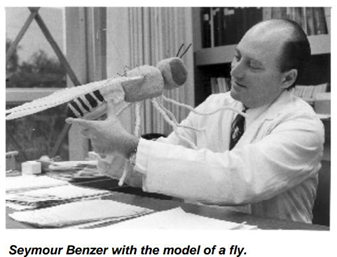We have 2 different strains of fruit flies
The whole work is about these 2 strains of flies.
The lab bred strain (culture) which is the standard and the other being the native strain…i.e. from the environment.
STANDARD CULTURE OF FLIES:
There is a story of these so called standard flies.
Seymour Benzer is an American physicist, molecular biologist and behavioral geneticist.

One of the standard flies of species Drosophila melanogaster, Canton special Benzer(CsBz) type isolated by Seymour Benzer has been bred in the research laboratories since more than 70-80 years now. Since, the life cycle of these flies is 10-12 days, it means that more than 2000 generations of these CsBz flies have been lab bred, i.e. no predators, no hunt for food.
These flies and its further generations are being bred in this media for the past 70-80 years.
So when the flies are old, they die. Their progenies take further their generations by laying eggs, then larva, pupa and the adult flies.
NATIVE FLY CULTURES:
Flies are trapped from the native environment inside a trap which has a bait.
These flies are brought into the lab and then a single gravid fly (a pregnant female fruit fly) is transferred into an already prepared standard media bottle .
This gravid fly will lay eggs, then larvae, pupae and adult flies.
These adult flies are then identified to be belonging to a particular species.
We are interested in the species of D. melanogaster .
So,
Now, as the details about the 2 strains are clear to everyone,
We can move on to the next part that is understanding our objective doing all this.
I’ll first tell about the long term objective that we have:
Long Term Objective:
Comparing the olfactory senses of the Lab bred and the native D.melanogaster for providing evolutionary evidences.
Quite complicated for some of them…
Its ok, we can make it easy…
For achieving this long term objective of ours
We have to achieve our immediate and short term objectives.
Immediate objective:
Trap flies and also make media.
Once the trapping is done, culturing and maintaining these flies is also an objective.
As for our long term objective achievement, larvae of these flies are necessary.
So, for that, we need flies.
Flies are cultured in cornmeal media bottles…which is a standard media.
Making Single Line Cultures (SLCs) another objective.
Why a single line?
When we trap flies, we might get flies belonging to different species.
And for our long term objective, we need the D. melanogaster species.
So, for obtaining a Single Line Culture with all the flies belonging to a one specific species, a gravid fly is put into a media bottle and then we keep it closed using a cotton plug.
Within 8-10 days, we get a new generation of flies…all belonging to the same mother…i.e. all are of one species.
Short Term Objective:
Identifying these single line cultures as belonging to a particular species is another objective.
We make many such single lines expecting some of them to be of D. melanogaster species.
Some of these single line cultures might be of some other species like D. simulans, D. suzukii etc.
Once, some of them are identified to be of melanogaster species,
Then we can move on to our next objective.
Our next objective is to perform the olfactory assay.
This assay is done with both the standard (lab bred) D. melanogaster flies as well as the native D. melanogaster (single lines)
Control runs and test runs are done in this assay and an ORI (Olfactory Response Index) is taken from these runs that we do.
Drosophila have olfaction as their primary sensory function. Considering this as a parameter, the chemical IAA (Iso amyl acetate - banana-like smelling compound) is used as an odorant for this olfactory assay to find the olfactory response index with different dilutions of the chemical.
There are some genes that are present on the antennae and the maxillary palp (mouth like structure). The receptors present here helps in functioning of the other olfactory receptors.
We obtain the threshold, and then a comparison is made between the lab bred and the native D. melanogaster and we check whether there are any mutations or alteration in these genes.
HYPOTHESIS:
Without the hypothesis or expectations, how will we understand?
What we hypothesize here is that, the CsBz flies which are the lab bred standard flies will have a deprived olfaction as compared to the native single line D. melanogaster .
This may be due to the mutations of some olfactory receptors (of CsBz flies) leading to inactivation of these receptors, which used to bind to the smell molecules but now have no affinity towards the odorant.
At the same time, in the native environment, the fruit flies with deprived olfaction, not being able to reach their food, starve and die. Hence the best ones are able to survive.
It’s like the survival of the fittest.
Natural selection takes place.
And hence the flies that we have with us are the ones that have the best olfaction and hence are more olfactory sensitive than the lab bred CsBz standard D. melanogaster .
So in general,
There is a comparison being made as well as there is a greater objective than this.
Here,
Drosophila is being developed as a model organism.
For studying Natural selection as well.
Back to home page for more details ![]()